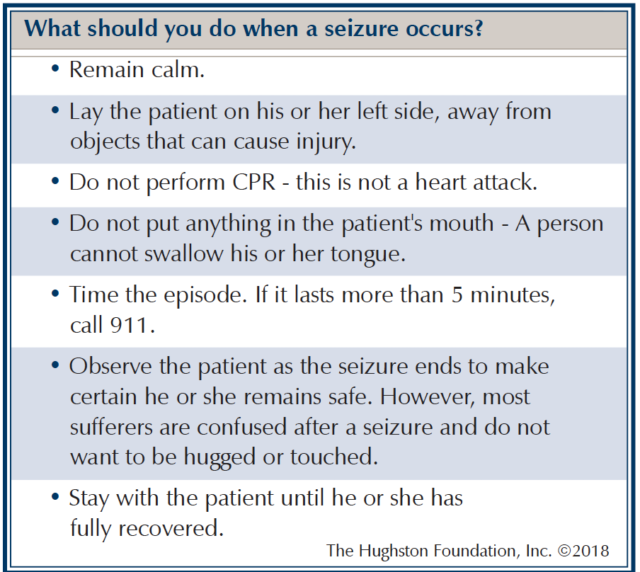
Approximately 1 out of every 2,000 children suffer from a seizure disorder. Because seizures can strike at any time and frequently cause a change in consciousness, falls, bladder incontinence, tongue biting, and muscle soreness, they are often associated with depression, anxiety, and low self-esteem. Finding ways in which a child with a seizure disorder can participate fully in life’s every-day activities can foster a better sense of well-being and improve opportunities for success.
What is a seizure?
A seizure is an abnormal electrical discharge in the brain. The brain contains billions of nerve cells called neurons. These neurons produce electrical impulses to send messages to other cells in the body; for instance, when you move your left arm, a subset of neurons in the brain that are responsible for left arm movement send electrical impulses down through the spinal cord and out to the muscles that control your left arm. When the brain records a memory, neurons responsible for storing the new experience are electrically activated in the area of the brain responsible for memory storage. Likewise, there are neurons constantly discharging electricity to control heart rate, breathing, and blood pressure. Because the brain is responsible for every aspect of who we are—consciousness, sleeping, thinking, moving, sensing, etcetera—an electrical “short circuit”, called a seizure, can present itself in a variety of ways based on where in the brain the abnormal discharge occurred.
Why do some people have seizures?
Any brain can have a seizure, but some brains are more prone to have seizures than others. Generally, a person has epilepsy if he or she has more than 1 seizure. Many people with epilepsy are born with microscopic abnormalities that cause “short circuits” producing seizures. Others are born with normal brains that are injured by car accidents, falls, stroke, or infection. The risk of seizure and subsequent epilepsy increases if these injuries or abnormalities are located in places where neurons are present.
How can a person with epilepsy decrease the risk of a seizure?
Placing additional stress on the brain can increase the risk of seizures. Some of the stresses are unavoidable, such as a woman’s menstrual cycle or becoming ill; however, many potential seizure triggers are manageable. For people who are at risk for seizures, physicians recommend the following:
- Get adequate sleep every night
- Treat fevers aggressively with appropriate doses of acetaminophen
- Get extra rest when feeling ill
- Take anti-seizure medication as prescribed
- Avoid medications that interfere with anti-seizure medication. Read the labels.
- Avoid alcohol
What about sports participation?
Any person with a chronic illness has to alter his or her lifestyle to some degree. The diabetic must avoid sweets. The asthmatic needs to carry an inhaler. Food allergy sufferers must remain vigilant about every item eaten. However, it is important not to limit activity or restrict lifestyle preferences if the associated risks, related to the underlying health problem, can be acceptably managed. Allowing a person with chronic illness to function as independently and as normally as possible is the overall goal. We use the term “acceptably managed” carefully, as each person and his or her loved ones must determine how much risk is acceptable. In the case of epileptics (seizure sufferers), activities that carry minimal risk should not be restricted.
While there are scientific studies that indicate that vigorous sport participation can increase the risk of seizures, other large studies demonstrate the additional risk is quite small. Therefore, the decision about sports participation should not be based on whether a sport increases the risk of seizures, but rather how often the child in question has a seizure and how much injury would be risked if a seizure occurred during participation. For instance, a child participating in most aspects of track and field has little more chance of injury than having a seizure in the classroom, home, or shopping center. Healthy or unhealthy, anyone in the pool should have a person who is attentive and able to help in an emergency. Yet, if a child were having frequent seizures, it would not make sense to put him or her in a position where an urgent rescue would likely be needed. Because driving is the ultimate danger, it is probably unreasonable to restrict sports participation in an athlete who has enough seizure control to drive legally.
When thinking about contact sports, where head trauma is commonplace (football, soccer, boxing, etc.), it does not make sense for anyone to participate. We know that sports like these are unhealthy for the brain. None of us are so overly gifted that losing brain cells from concussion is acceptable. Yet, a person with seizures likely has very little extra risk from participating. Therefore, the decision for a well-controlled epileptic to participate should not be based on the risk of seizure, but rather the overall risk of further damaging the brain by heading the ball, tackling hard, or taking a roundhouse punch to the head. While participating in sports is likely to be acceptable in most reasonably controlled epileptics, the athlete should attempt to remain adequately hydrated, obtain reasonable rest, and have access to his or her normal dosing of anti-seizure medication.

Most sporting opportunities should be open to people with well-controlled seizures if the harm that can occur during a seizure is reasonable. For people with less well-controlled seizures, it is not just the physical risk of having a seizure that should be considered, but also the emotional toll it can take on a fragile ego to have an uncontrolled event in the midst of a crowd. It may make more sense for this type of epilepsy sufferer to participate in sports with small gatherings; in safer environments, where close oversight is possible. The patient and family should discuss these issues when making decisions about sports participation. Once potential problems are identified and appropriate allowances are made to mitigate these issues, it should be possible for most seizure suffers to participate safely in a variety of sports and activities.
Author: Jonathan L. Liss, MD | Columbus, Georgia
Vol. 30, Number 3, Summer 2018
Last edited on October 18, 2021